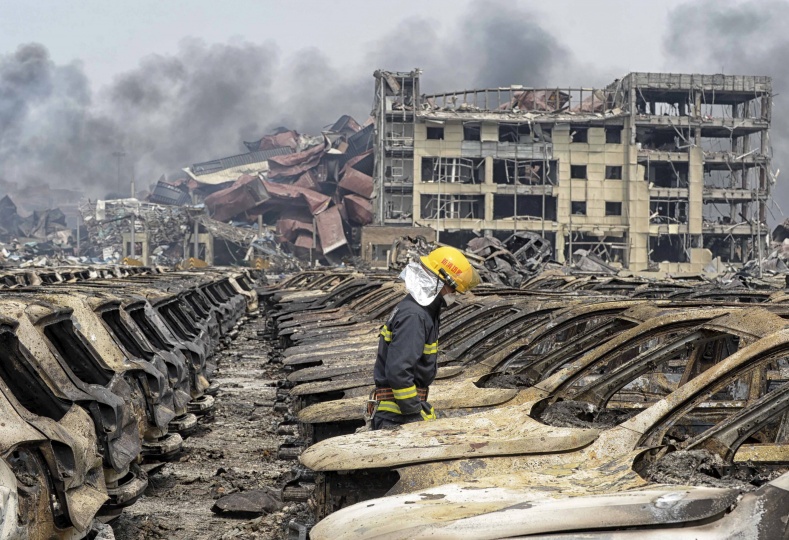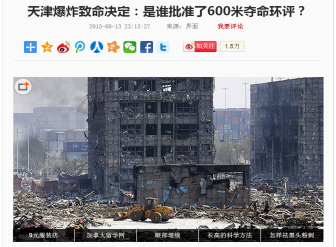Chinese Media Investigate Deadly Tianjin Explosion

In spite of official efforts to control news coverage of last week’s deadly explosions in the Chinese port city of Tianjin, Chinese media have responded swiftly not only to cover the fast-moving disaster, but also to probe the why and how of the tragedy.
Within hours of the blast, leading Chinese media, both traditional and online, began investigating reasons for the toxic facilities to be built next to residential developments, the ownership of the storage, the failure of government oversight, and the botched response to the disaster.
Late Wednesday night, a warehouse storing toxic chemicals in Tianjin burst into two massive explosions, marking one of the deadliest industrial accidents in recent Chinese history. By Monday, officials reported 114 dead, including 39 fire fighters, and more than 700 injured. The death toll is rising as the site was hit by a series of new explosions on Saturday, with scores still missing.

Coverage by Jiemian, an online business site, tracked down ownership of the facility and questioned how it was approved in an area with residences and a hospital.
Chinese media leading the investigative reports include state-owned outlets, market-oriented media, and news departments of leading Internet companies such as Tencent and Netease. Seventeen hours after the blast, the news department of Netease, a major Internet company, reported the violations with both text and graphics. Using information from real estate developers, the Netease investigative team, named Guidepost, reported that the toxic facility was built less than one kilometer from three residential high-rise complexes in violation of government stipulation. More than 5,600 families live in the buildings, according to Guidepost.
Hours later, Tencent, the online giant, published an interactive map from satellite images, before-and-after photos of the blast site and public data, illustrating how the location of the storage violated regulations issued in 2001 by the State Bureau of Safety governing business use of toxic chemicals.
Both Tencent and Jiemian, an online business media under the Shanghai United Media Group funded by a mix of state and private money, found that the storage facilities were built after the residences and the hospital, raising the question of how the project passed environmental impact scrutiny. In interviews with the media, residents and a spokesman for Wanke, a developer in the area, said that they had no knowledge that the toxic storage was sited in their neighborhood.
The news media, including Beijing News, a daily city tabloid under the Beijing municipal government, also dug into how the company secured approval in the environmental impact review. According to the paper, the Tianjin Academy of Environmental Science gave a green light to the project, claiming that “100% of the public supported the location of the site.” The Academy cited its poll based on 128 of 130 distributed questionnaires. Residents, however, told reporters that they have never been consulted on the toxic project.
The Paper, another digital media under the Shanghai United Media Group, weighed in by posting an official document announcing approval of the toxic facility issued by the Tianjin Academy on May 24, 2013.
Using company registration records, Caixin, a leading business weekly, identified members of the board of directors of Ruihai International Logistics, registered owners of the storage facility, and their connections with other companies. The story was published a day after the blast.
On the next day, Jieman reported the company’s connections with Sinochem Tianjin of the Sinochem Group, a mega state-owned enterprise in China, in a story titled “Ruihai Has Mysterious Background; Tied to State-Enterprise Sinochem.”
Another topic of investigation has been the way firefighters plunged into the burning site, only to get trapped by the explosions minutes later. Firefighters reportedly used water on the fire, since they had not been warned about the chemicals in the facility. The story, broken last Thursday by the Guangzhou-based Southern Weekly, has since become inaccessible.
In an exclusive story on Thursday night, Caixin reported that the squad of firefighters who arrived first at the site and suffered the greatest casualty were contract employees, not members of the regular civil service. All 25 members of the fire squad have been missing or found dead. Authorities have been evasive about the deployment of the contract workers and their plight.
Meanwhile, officials have imposed tighter control of the news by deleting social media and other online posts, and by blocking reporters from access to the disaster scene. Already, propaganda officials have reportedly sent instructions to the media that they must use only dispatches on the blast from Xinhua News, the state news agency. Investigative editors and reporters know that they must race against time to get out the facts behind the deadly blasts. They need to get the story to the public before officials order a total shutdown on reporting about the Tianjin disaster. That gag order, Chinese journalists say, could arrive any time.
Sources used by China's news media in this investigation include:
GOVERNMENT INFORMATION
1)环评报告EIA (Environmental Impact Assessment) Reports
天津东疆保税港区瑞海国际物流有限公司跃进路堆场改造工程环境影响评价第二次公众参与公示.docx
塘环监(项目验收)字(2014)第25号-天津东疆保税港区瑞海国际物流有限公司跃进路堆场改造工程建设项目竣工环境保护验收监测报告.docx
《天津东疆保税港区瑞海国际物流有限公司跃进路堆场改造工程竣工环境保护验收批复公示》 (1).jpg
《天津东疆保税港区瑞海国际物流有限公司跃进路堆场改造工程竣工环境保护验收批复公示》 (2).jpg
《天津东疆保税港区瑞海国际物流有限公司跃进路堆场改造工程竣工环境保护验收批复公示》 (3).jpg
《天津东疆保税港区瑞海国际物流有限公司跃进路堆场改造工程竣工环境保护验收批复公示》 (4).jpg
2)国家安监局等发布的相关法律法规
State Administration of Work Safety
3)天津市安监局
Tianjin Administration of Work Safety
4)天津交委官方网站
Tianjin Municipal Transportation Commission
5)国务院发布的相关法律法规
Laws and regulations issued by the State Council, PRC
6)天津市环境空气质量GIS发布平台-空气质量指数
AQI data by Tianjin Environment Monitoring Center (published on the GIS platform)
7)天津市海事局网站
Tianjin Maritime Safety Administration
8)天津市市场主体信用信息公示系统
Tianjin Market and Quality Supervision Administration
9)天津滨海新区行政审批服务网上办事大厅
Tianjin Binhai online service center for administrative approval (No official translation)
COMPANY INFORMATION
1)天津东疆保税港区瑞海国际物流有限公司官网
Official website of the Rui Hai Logistics Company Limited
2)工商注册信息(全国企业信用信息公示系统)
National enterprise credit information publicity system
PUBLIC INFORMATION
1)卫星地图 Google satellite map
2)爆炸现场图片前后对比(网络、媒体)photos before and after the blasts
3)地图测距-仓库与居民楼距离 estimation of distance with Google/Baidu mapping
4)公开信息-仓库、居民楼、高速公路和轻轨站建设时间 public information on the internet
5)中国水运网

































































































